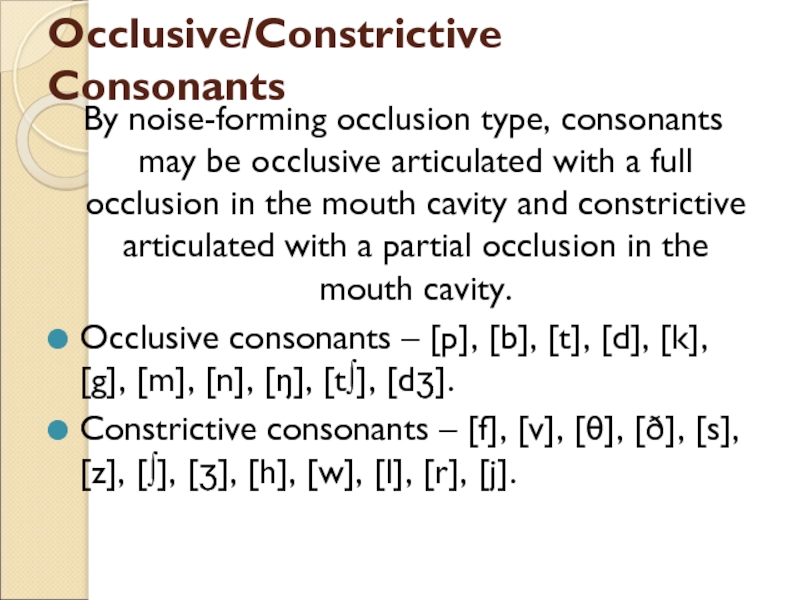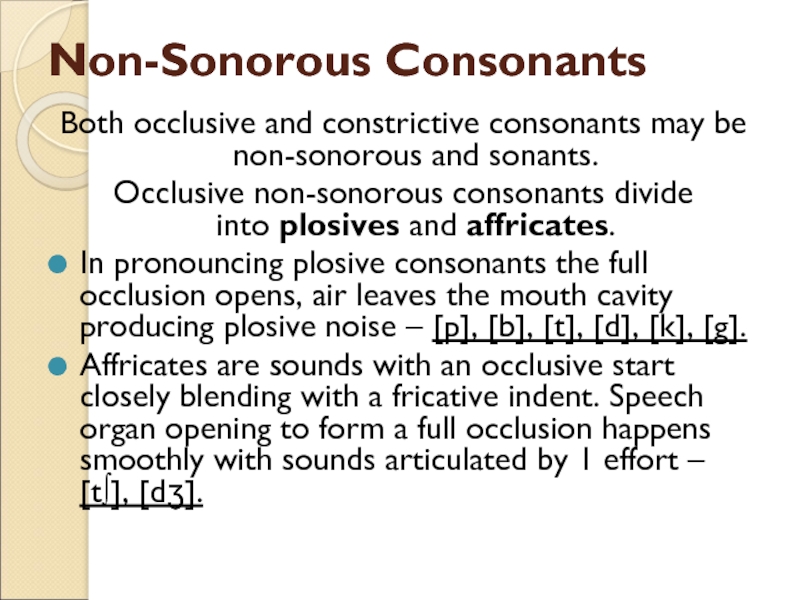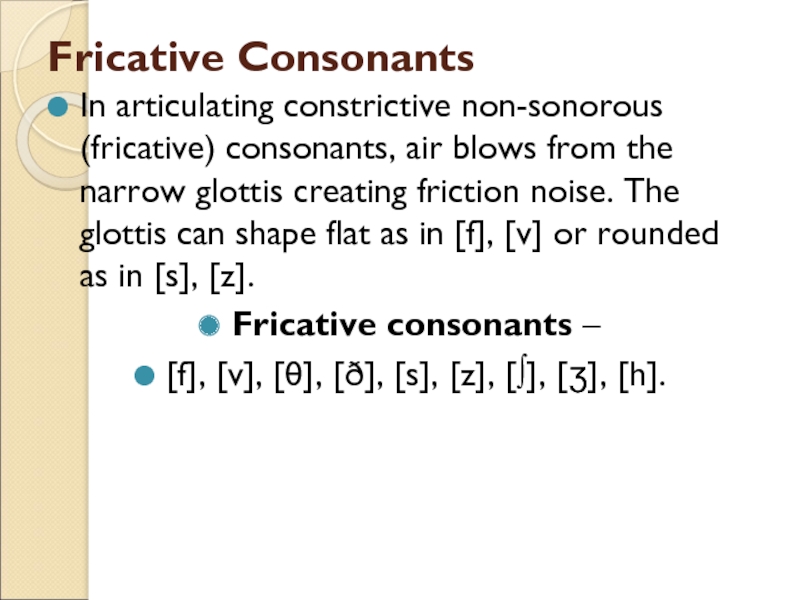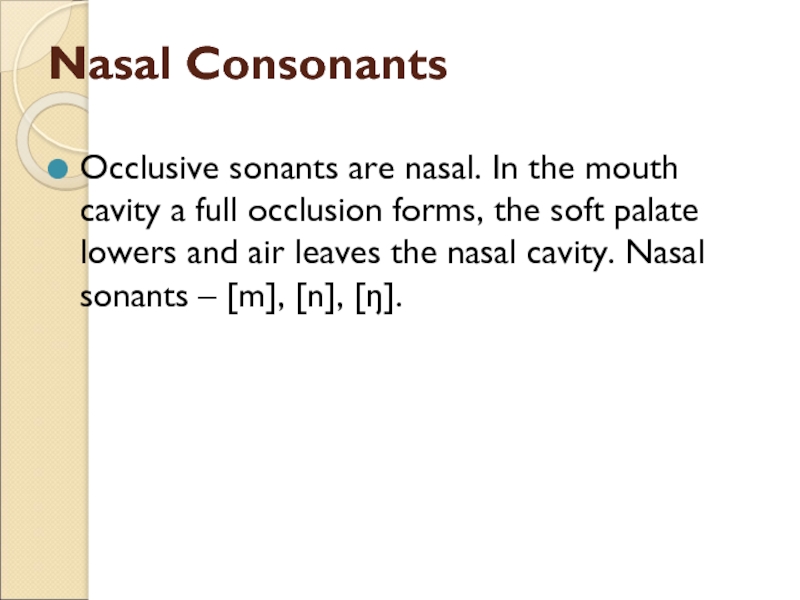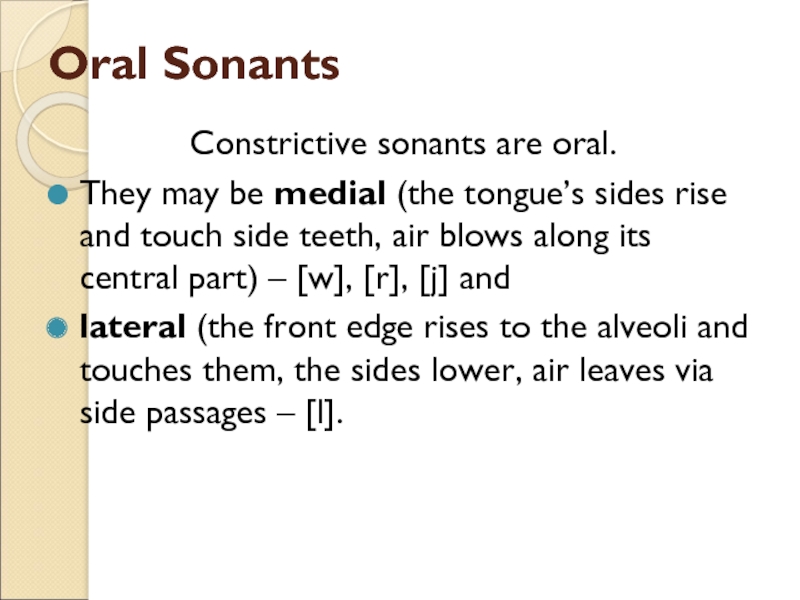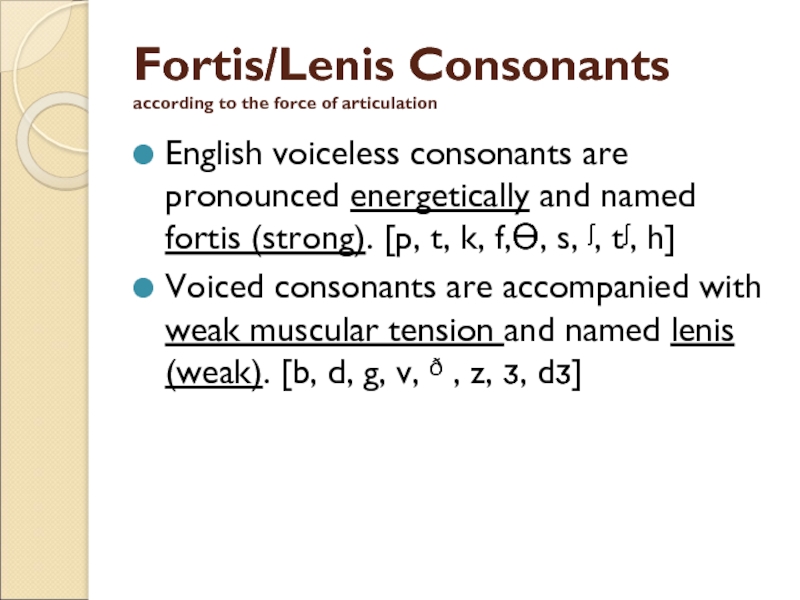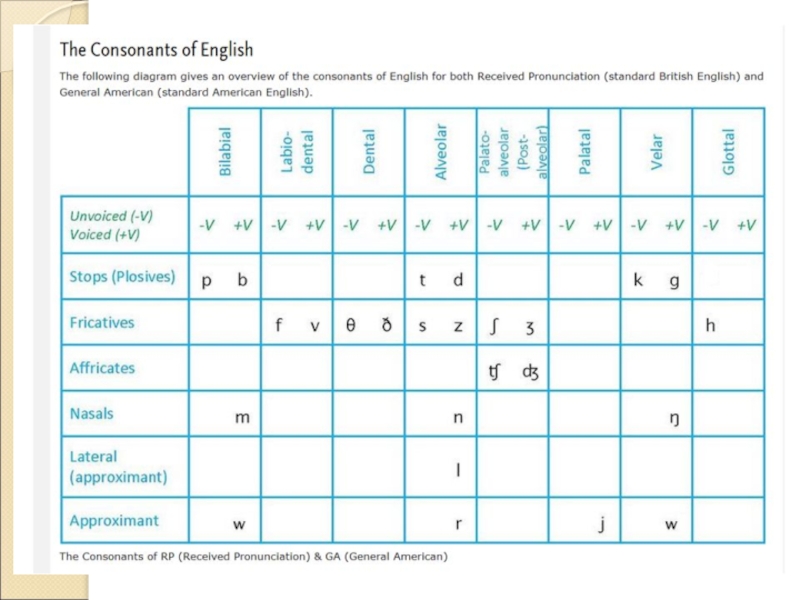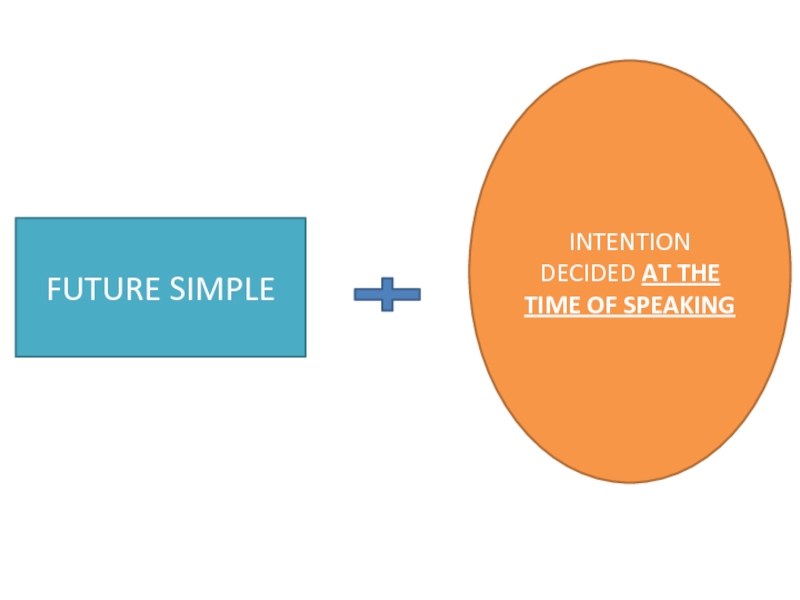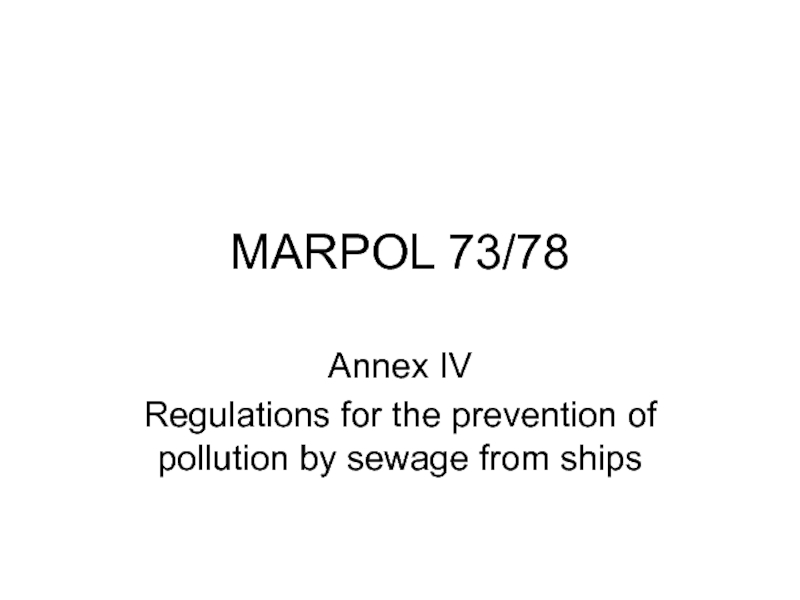- Главная
- Разное
- Дизайн
- Бизнес и предпринимательство
- Аналитика
- Образование
- Развлечения
- Красота и здоровье
- Финансы
- Государство
- Путешествия
- Спорт
- Недвижимость
- Армия
- Графика
- Культурология
- Еда и кулинария
- Лингвистика
- Английский язык
- Астрономия
- Алгебра
- Биология
- География
- Детские презентации
- Информатика
- История
- Литература
- Маркетинг
- Математика
- Медицина
- Менеджмент
- Музыка
- МХК
- Немецкий язык
- ОБЖ
- Обществознание
- Окружающий мир
- Педагогика
- Русский язык
- Технология
- Физика
- Философия
- Химия
- Шаблоны, картинки для презентаций
- Экология
- Экономика
- Юриспруденция
English Consonants. Classification презентация
Содержание
- 1. English Consonants. Classification
- 2. Things to know! Received Pronunciation (standard British
- 3. English consonants are categorized as to: articulation
- 4. Articulation place and active organ Depending on
- 5. Labial Consonants bilabial articulated with both lips –
- 6. Lingual Consonants -Forelingual consonants: interdental (predorsal dental) – [θ], [ð] (the
- 7. Glottal Consonant The only English glottal [h]
- 8. Occlusive/Constrictive Consonants By noise-forming occlusion type, consonants
- 9. Non-Sonorous Consonants Both occlusive and constrictive consonants may
- 10. Fricative Consonants In articulating constrictive non-sonorous (fricative)
- 11. Nasal Consonants Occlusive sonants are nasal.
- 12. Oral Sonants Constrictive sonants are oral.
- 13. Fortis/Lenis Consonants according to the force of
Слайд 2Things to know!
Received Pronunciation (standard British English) – we should speak
this one!
General American (standard American English)
General American (standard American English)
Слайд 3English consonants are categorized as to:
articulation place and active organ
occlusion type
noise
formation
noise-forming occlusions number
vocal cords work
pronunciation force.
noise-forming occlusions number
vocal cords work
pronunciation force.
Слайд 4Articulation place and active organ Depending on what active or passive speech
organs articulate a speech sound, consonants may be:
Labial Consonants
Lingual Consonants
Glottal Consonant
Слайд 5Labial Consonants
bilabial articulated with both lips – [w], [m], [p], [b]
labiodental articulated with
the lower lip and upper teeth – [f], [v].
Слайд 6Lingual Consonants
-Forelingual consonants:
interdental (predorsal dental) – [θ], [ð]
(the tongue’s front surface forms a partial occlusion
with the upper teeth);
apical alveolar – [t], [d], [n], [l], [s], [z], [∫], [ʒ], [t∫], [dʒ] (the front edge rises to the alveolar ridge);
cacuminal post-alveolar – [r] (the front edge is raised and a little bent to the alveolar back slope).
In mediolingual consonants an occlusion is formed by raising the middle part to the hard palate. Such is articulating the only English dorsal palatal [j] sound.
-Backlingual consonants are articulated by raising the back part to the soft palate – [k], [g], [ŋ]. These are dorsal velar sounds.
apical alveolar – [t], [d], [n], [l], [s], [z], [∫], [ʒ], [t∫], [dʒ] (the front edge rises to the alveolar ridge);
cacuminal post-alveolar – [r] (the front edge is raised and a little bent to the alveolar back slope).
In mediolingual consonants an occlusion is formed by raising the middle part to the hard palate. Such is articulating the only English dorsal palatal [j] sound.
-Backlingual consonants are articulated by raising the back part to the soft palate – [k], [g], [ŋ]. These are dorsal velar sounds.
Слайд 7Glottal Consonant
The only English glottal [h] sound forms in the glottis. Exhaled
air goes via the narrowed glottis with a slight friction noise, the vocal cords don’t vibrate, speech organs in super-glottal cavities shape to pronounce a vowel after the glottal consonant.
What is a glottis?
What is a glottal stop?
What is a glottis?
What is a glottal stop?
Слайд 8Occlusive/Constrictive Consonants
By noise-forming occlusion type, consonants may be occlusive articulated with
a full occlusion in the mouth cavity and constrictive articulated with a partial occlusion in the mouth cavity.
Occlusive consonants – [p], [b], [t], [d], [k], [g], [m], [n], [ŋ], [t∫], [dʒ].
Constrictive consonants – [f], [v], [θ], [ð], [s], [z], [∫], [ʒ], [h], [w], [l], [r], [j].
Occlusive consonants – [p], [b], [t], [d], [k], [g], [m], [n], [ŋ], [t∫], [dʒ].
Constrictive consonants – [f], [v], [θ], [ð], [s], [z], [∫], [ʒ], [h], [w], [l], [r], [j].
Слайд 9Non-Sonorous Consonants
Both occlusive and constrictive consonants may be non-sonorous and sonants.
Occlusive non-sonorous
consonants divide into plosives and affricates.
In pronouncing plosive consonants the full occlusion opens, air leaves the mouth cavity producing plosive noise – [p], [b], [t], [d], [k], [g].
Affricates are sounds with an occlusive start closely blending with a fricative indent. Speech organ opening to form a full occlusion happens smoothly with sounds articulated by 1 effort – [t∫], [dʒ].
In pronouncing plosive consonants the full occlusion opens, air leaves the mouth cavity producing plosive noise – [p], [b], [t], [d], [k], [g].
Affricates are sounds with an occlusive start closely blending with a fricative indent. Speech organ opening to form a full occlusion happens smoothly with sounds articulated by 1 effort – [t∫], [dʒ].
Слайд 10Fricative Consonants
In articulating constrictive non-sonorous (fricative) consonants, air blows from the
narrow glottis creating friction noise. The glottis can shape flat as in [f], [v] or rounded as in [s], [z].
Fricative consonants –
[f], [v], [θ], [ð], [s], [z], [∫], [ʒ], [h].
Fricative consonants –
[f], [v], [θ], [ð], [s], [z], [∫], [ʒ], [h].
Слайд 11Nasal Consonants
Occlusive sonants are nasal. In the mouth cavity a full
occlusion forms, the soft palate lowers and air leaves the nasal cavity. Nasal sonants – [m], [n], [ŋ].
Слайд 12Oral Sonants
Constrictive sonants are oral.
They may be medial (the tongue’s sides rise
and touch side teeth, air blows along its central part) – [w], [r], [j] and
lateral (the front edge rises to the alveoli and touches them, the sides lower, air leaves via side passages – [l].
lateral (the front edge rises to the alveoli and touches them, the sides lower, air leaves via side passages – [l].
Слайд 13Fortis/Lenis Consonants
according to the force of articulation
English voiceless consonants are pronounced energetically
and named fortis (strong). [p, t, k, f,Ө, s, ᶴ, tᶴ, h]
Voiced consonants are accompanied with weak muscular tension and named lenis (weak). [b, d, g, v, ᶞ , z, ᴣ, dᴣ]
Voiced consonants are accompanied with weak muscular tension and named lenis (weak). [b, d, g, v, ᶞ , z, ᴣ, dᴣ]
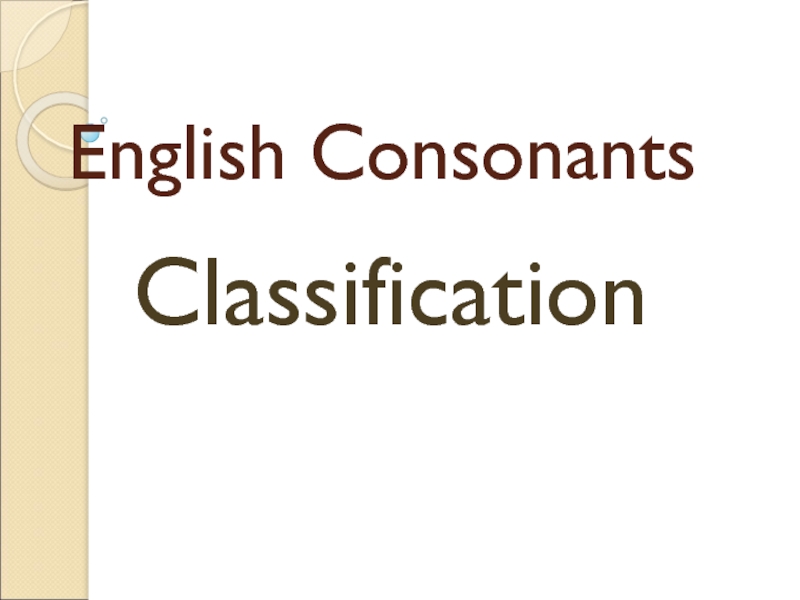
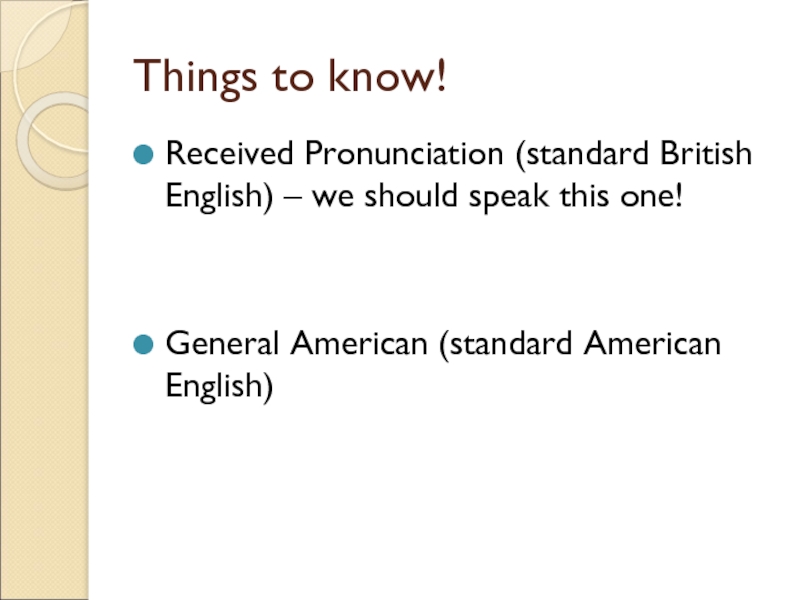
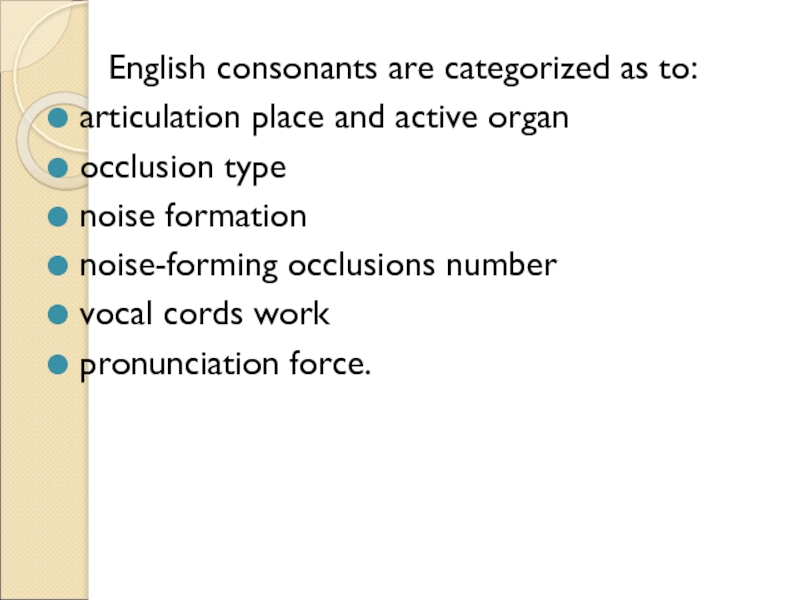
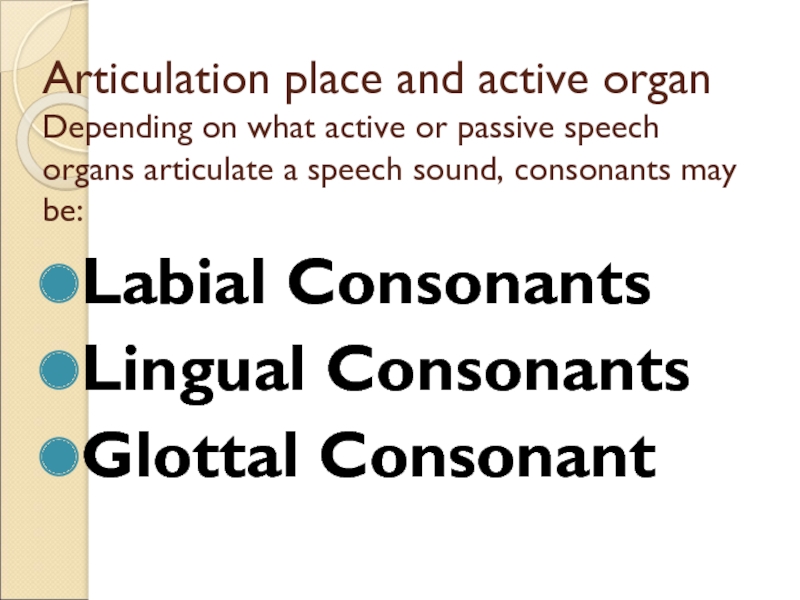
![Labial Consonantsbilabial articulated with both lips – [w], [m], [p], [b]labiodental articulated with the lower lip and](/img/tmb/6/509048/1caf86f70a72ad036b8986b1f30dd9bc-800x.jpg)
![Lingual Consonants-Forelingual consonants:interdental (predorsal dental) – [θ], [ð] (the tongue’s front surface forms a partial occlusion with the upper](/img/tmb/6/509048/e244bebd9355755144e199c6750cd33d-800x.jpg)
![Glottal Consonant The only English glottal [h] sound forms in the glottis. Exhaled air goes via](/img/tmb/6/509048/57553d8d5b58a54be22363ced2f99f2f-800x.jpg)
